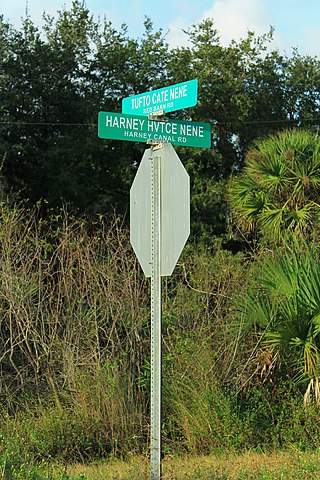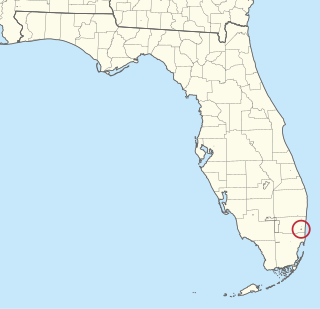
The Seminole are a Native American people who developed in Florida in the 18th century. Today, they live in Oklahoma and Florida, and comprise three federally recognized tribes: the Seminole Nation of Oklahoma, the Seminole Tribe of Florida, and the Miccosukee Tribe of Indians of Florida, as well as independent groups. The Seminole people emerged in a process of ethnogenesis from various Native American groups who settled in Spanish Florida beginning in the early 1700s, most significantly northern Muscogee Creeks from what are now Georgia and Alabama.

Chikee or Chickee is a shelter supported by posts, with a raised floor, a thatched roof and open sides. Chickees are also known as chickee huts, stilt houses, or platform dwellings. The chickee style of architecture—palmetto thatch over a bald cypress log frame—was adopted by Seminoles during the Second (1835–42) and Third (1855-58) Seminole Wars as U.S. troops pushed them deeper into the Everglades and surrounding territory. Before the Second Seminole War, the Seminoles had lived in log cabins. Similar structures were used by the tribes in south Florida when the Spanish first arrived in the 16th century. Each chickee had its own purpose and together they were organized within a camp-type community. Chickees were used for cooking, sleeping, and eating.

The Miccosukee Tribe of Indians is a federally recognized Native American tribe in the U.S. state of Florida. Together with the Seminole Nation of Oklahoma and the Seminole Tribe of Florida, it is one of three federally recognized Seminole entities.
The Mikasuki, Hitchiti-Mikasuki, or Hitchiti language is a language or a pair of dialects or closely related languages that belong to the Muskogean languages family. As of 2014, Mikasuki was spoken by around 290 people in southern Florida. Along with the Cow Creek Seminole dialect of Muscogee, it is also known as Seminole. It is spoken by members of the Miccosukee tribe and of the Seminole Tribe of Florida. The extinct Hitchiti was a mutually intelligible dialect of or the ancestor of Mikasuki.

The Big Cypress Indian Reservation is one of the six reservations of the Seminole Tribe of Florida. It is located in southeastern Hendry County and northwestern Broward County, in southern Florida, United States. Its location is on the Atlantic coastal plain. This reservation lies south of Lake Okeechobee and just north of Alligator Alley. It is governed by the Seminole Tribe of Florida's Tribal Council, and is the largest of the five Seminole reservations in the state. Facilities on the reservation include the tribal museum and a major entertainment and rodeo complex.

Nene is a word in the Muscogee language of the Seminole Indians meaning "path" or "trail."
Ar-pi-uck-i, also known as Abiaka or Sam Jones, was a powerful spiritual alektca and war chief of the Miccosukee, a Seminole–Muscogee Creek tribe of the Southeast United States. Ar-pi-uck-i successfully defied the U.S. government and refused to remove to the Indian Territory west of the Mississippi and his influential leadership in the Second Seminole War (1835–1842) resulted in the permanent Native American presence in Florida.

The Miccosukee Indian Reservation is the homeland of the Miccosukee tribe of Native Americans. It is divided into three sections in two counties of southern Florida, United States. Their total land area is 128.256 sq mi (332.18 km2). The Miccosukee Reservation have members living on and off the reservation.

Hollywood Reservation, formerly known as the Dania Reservation, is one of six Seminole Indian reservations governed by the federally recognized Seminole Tribe of Florida, located near Hollywood, Florida. The reservation is bordered by the communities of Hollywood and Davie, in Broward County. The reservation is 497 acres (2.01 km2) in size.
The Seminole Tribe of Florida is a federally recognized Seminole tribe based in the U.S. state of Florida. Together with the Seminole Nation of Oklahoma and the Miccosukee Tribe of Indians of Florida, it is one of three federally recognized Seminole entities. It received that status in 1957. Today, it has six Indian reservations in Florida.

The Seminole Nation of Oklahoma is a federally recognized Native American tribe based in the U.S. state of Oklahoma. It is the largest of the three federally recognized Seminole governments, which include the Seminole Tribe of Florida and the Miccosukee Tribe of Indians of Florida. Its citizens are descendants of the approximately 3,000 Seminoles who were forcibly removed from Florida to Indian Territory, along with 800 Black Seminoles, after the Second Seminole War. The Seminole Nation of Oklahoma is headquartered in Wewoka within Seminole County, Oklahoma. Of 18,800 enrolled tribal citizens, 13,533 live in Oklahoma. The tribe began to revive its government in 1936 under the Indian Reorganization Act. While its reservation was originally larger, today the tribal reservation and jurisdictional area covers Seminole County, Oklahoma, within which it has a variety of properties.
Uchee Billy or Yuchi Billy was a chief of a Yuchi band in Florida during the first half of the 19th century. Uchee Billy's band was living near Lake Miccosukee when Andrew Jackson invaded Spanish Florida during the First Seminole War and attacked the villages in the area. Yuchi Billy and his band then moved to the St. Johns River. During the Second Seminole War, Uchee Billy was an ally of the Seminoles, and was one of the principal war chiefs who fought the U.S. Army.

The Tampa Reservation is one of six Seminole Indian reservations governed by the federally recognized Seminole Tribe of Florida. It is located in Hillsborough County, Florida.
William Buffalo Tiger was a political leader of the Miccosukee Nation based in the Everglades area of Florida. He served as the first elected tribal chairman from 1962 to 1985, and before that was head of the General Council from 1957 and a chief. His activism led to political organization of the Miccosukee and their gaining federal recognition in 1962 as an independent Native American tribe. They wrote a constitution to govern their people.

Bill Osceola was the first president of the Seminole Tribe of Florida. When the federal government marked his tribe for termination, Osceola came up with the idea of creating a rodeo as a tourist attraction to raise funds. The rodeo earned enough money to pay for tribal representatives to lobby against termination and formally organize as a tribe.

Billy Osceola, was the first elected chief of the Seminole Tribe of Florida. He became an ordained minister and was extremely influential in shifting the Seminole Tribe of Florida from traditional spiritual practices to the Baptist faith. He was the first elected chairman of the tribe after their 1957 reorganization.

Josie Billie was a Mikasuki-speaking Seminole medicine man, doctor, and Baptist preacher. Billie was a member of the Panther clan of the Seminoles in southern Florida. He actively collaborated with American anthropologists and researchers like Ethel Cutler Freeman, Frances Densmore, Robert Greenlee, Robert Solenberger and William Sturtevant. Billie served as a public spokesman for the Florida Seminoles and created recordings of traditional folk songs and information about the traditional Seminole religion. As of 2017, his camp is part of the Tribal Register of Historic Places.
Seminole patchwork, referred to by Seminole and Miccosukee women as Taweekaache, is a patchwork style made from piecing colorful strips of fabric in horizontal bands. Seminole patchwork garments are often trimmed with a rickrack border. Early examples of this technique are known from photographs in the 1910s, and its use by Seminole women in garment construction began to flourish in the 1920s. Seminole patchwork has historically been an important source of income for many Seminole women, and today remains a source of cultural pride. Fashion designers, including Donna Karan, have been criticized for their appropriation of this patchwork style.
Spanish Indians was the name Americans sometimes gave to Native Americans living in southwest Florida and in southernmost Florida during the first half of the 19th century. Those people were also sometimes called "Muspas". Seminoles, Muscogees, Alabamas, and Choctaws were also reported to be living in southwest and southern Florida in the early 19th century. Many Native Americans were employed by and often resident at Spanish-Cuban fishing ranchos along the coast of southwest Florida. During the Second Seminole War, a band led by Chakaika that lived in the Shark River Slough in the Everglades was particularly called "Spanish Indians". The residents of the fishing ranchos and, after Chakaika's death in 1840, many people from his band, were sent west to the Indian Territory, and Spanish Indians were no longer mentioned in the historical record. Scholars long regarded the Spanish Indians as likely a surviving remnant of the Calusa people. More recent scholarship regards the Spanish Indians as Muskogean language-speakers who had settled in southern Florida in the 18th century and formed a close association with Spaniards, or were even beginning to form a Spanish-Native American creole people.















